Maintaining a hot tub requires regular care, from regularly testing and treating the water, to draining and deep cleaning, every step plays a crucial role in your spa’s health and longevity.
Beyond that, these maintenance steps also ensure your water remains clean and safe to enjoy so that you and your guests can reliably enjoy every second in the water.
When it comes time for your hot tub drain, you don’t want to be left in the dark, wondering what steps you need to take to give your spa the care it needs.
That’s where we come in. Below, you’ll discover an easy-to-follow, seven-step guide to hot tub drains and refills, ensuring you never miss a step.
Before we get into the steps, let’s first explore why hot tub drains are so important, and how you know it’s time to give your water a refresh.
How To Know It’s Time For a Hot Tub Drain
Ideally, you should be draining your hot tub every three to four months, however, this may vary based on how often you use your spa, and how many people are often in the water.
The higher the frequency of use, the sooner you’ll need to change your water.
With that said, you may be wondering, “How do I know if I need to drain my hot tub sooner?”
Here are some key indicators that you need to drain your hot tub:
- Difficulty balancing the chemistry: if you’ve recently noticed you’re having to frequently treat your water, and you’re using noticeably more product to do so, it’s likely time to change your water. As the TDS (total dissolved solids) of your water increases, it becomes more and more difficult to balance and is a sure sign your TDS has become too high.
- Water clarity issues: If your water starts looking cloudy or develops a murky undertone, you may need to refresh your water. This can also be caused by a pH imbalance, so before draining your spa, test the chemistry and bring everything back into balance first. If this doesn’t work, or the cloudiness continues returning, drain your spa.
- A foamy surface: When your water becomes overloaded with organic matter (like oils and dead skin cells), the foam may begin developing on the surface, becoming most notable when the jets fire up. You can try testing and treating your water as needed, but once foam appears, you’ll likely need to drain the spa.
- Unusual odors: Generally, a well-maintained hot tub will have little to no odor, and if you’ve lifted your cover and been hit with a foul smell, you’ll want to look into the culprit. This is most often caused by a lack of chlorine, but if your sanitizer levels are in range, draining your spa is your best option.
While many of these signs have alternative solutions, you’ll want to ensure you diagnose and troubleshoot them as soon as they appear.
If testing and rebalancing your water doesn’t work to clear up these issues, or they continue to return, a hot tub drain should be next on your list.
Above all, even if your water is showing no signs of concern, at the four-month mark, it’s time to set aside some time and drain your spa.
Pro tip: wait until the late (late) fall to do your winter drain. This will ensure you can avoid having to drain and refill your spa while there’s snow on the ground.
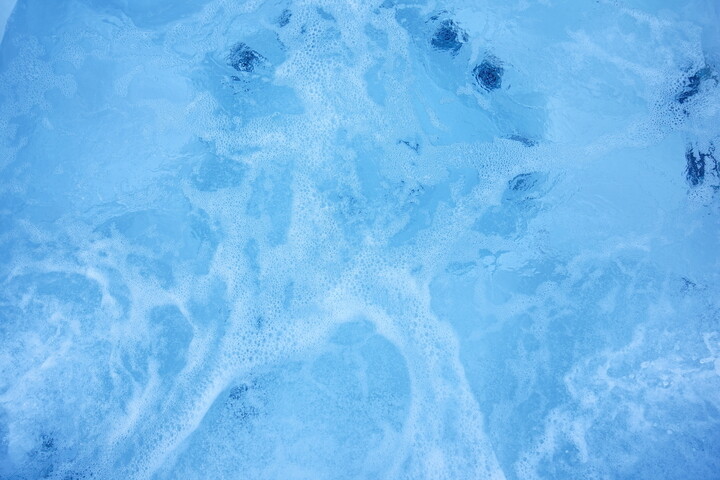
Step-by-Step Guide to Draining and Refilling Your Hot Tub
Now that you know when you’ll need to drain your hot tub, let’s get into exactly how to drain your spa.
An important note here is that your hot tub drain should always coincide with a deep clean, since the empty tub provides the perfect time to scrub the shell of any debris that’s adhered to its smooth surface.
Here’s everything you’ll need to drain and deep clean your hot tub :
- Pipe cleaner
- Filter cleaner
- Garden hose
- Submersible pump (if your spa doesn’t have a quick drain)
- Shell cleaner & non-abrasive cloth or sponge
- Pre-filter hose attachment (optional)
- Water treatment products
Step 1: Clean The Lines
The lines of your hot tub’s circulation system can only be cleaned one way: with a line cleaner—and this can only be done while there’s water in your spa.
Carefully follow the directions on your bottle of line cleaner, add a dose to the water, and let your jets run on low for 15 minutes.
This will allow the cleaner to circulate through your system, clearing away any surface debris that’s accumulated in your pipes.
Step 2: Power Down and Drain
After 15 minutes, you can turn your jets off and start the process of draining your spa.
Start by turning off the power to your spa. Then, open the cabinet’s control panel and locate your drain.
After attaching your nose to the drain, unravel it towards a spot in your yard that is away from your spa, and has good drainage.
Then, simply open the drain slice valve, and the water from your spa will begin to drain.
To speed this process up, try using a submersible pump.
Step 3: Clean Your Filters
Once your water has started to drain, you can turn your attention to your filters.
Your filters are constantly in contact with every contaminant that enters your water, catching it before it can flow back into your tub.
This makes their care exceptionally important, impacting not only the cleanliness of your water but the efficiency of your system!
To clean your filters, remove them from their housing and rinse them under a faucet. Ensure you use cool water.
Then, submerge them in a diluted solution of filter cleaner and water for 15 minutes. Alternatively, you could use a spray-on, rinse-off filter cleaner instead.
After they’re done soaking, thoroughly rinse them off and set them aside.
Watch this video for a visual guide, but note that your process may look slightly different based on your hot tub model:
Pro tip: For an even deeper clean, remove your filters the night before and soak them in a diluted mixture of filter cleaner and water overnight. This will help the cleaner deeply penetrate the pleats and leave you with (nearly) new-looking filters!
Step 4: Deep Clean
Once all the water has been drained from your hot tub, you can start giving it a good scrub.
Over time, contaminants in your water can accumulate on your shell, leaving a slightly slimy residue on its surface.
Giving your shell a thorough clean during your seasonal drain will help ensure no lingering impurities enter the clean water upon refilling the basin.
Use a cleaner specifically made for hot tub shells and a non-abrasive cloth to wash the entire interior of your spa, ensuring you wash around the jets to lift any hidden grime.
After you’re confident your shell is clean, use your hose to thoroughly rinse off any of the cleaner, letting it drain out of your spa completely.
Step 5: Inspect the Heating Element
While your spa is off and empty, it’s the perfect time to check your heating element for any corrosion or scale buildup.
When water is left unbalanced, it can damage your system, resulting in flakey scale building up on its surfaces or, if it’s too acidic, eating away at your shell and various components.
If too much of this damage occurs on your heating element, it can result in heating failure, making it imperative to check for any damage to your element each time you drain your spa.
This will help you track the effectiveness of your hot tub maintenance routine, and serve as a warning that heater failure may be on the horizon if it continues.
Step 6: Refill & Power On
At this point, your tub should be sparkly clean and ready to be refilled with fresh, clean water.
Before beginning, ensure you disconnect your hose from the drain spout and close your drain slice valve.
Once everything is back in order, you can begin refilling your spa with fresh water using your garden hose.
After you’ve refilled your spa to the recommended height, you can turn off your hose, remove it from your tub, and turn the power back on to your hot tub.
Pro tip: Use a pre-filter hose attachment to strip contaminants out of the water before they even enter your hot tub, ensuring you’re starting with the cleanest water possible.
Step 7: Test & Balance
Before you jump into your newly cleaned spa, you’ll want to rebalance your water.
As your water warms, test its chemistry using a pH test strip, and add the necessary amounts of water treatment products to rebalance everything.
To do this, you’ll need your sanitizer, and some variation of pH increaser, pH decreaser, and total alkalinity increaser.
You’ll want to ensure the levels are as follows:
- pH: 7.2-7.8
- Alkalinity: 80-120 ppm
- Chlorine: 1-3ppm or Bromine: 3-5ppm
Depending on your local water quality, you may also need a calcium hardness increaser or water softener.
If you’re unsure whether you should use these products, talk to your dealer. They can help you determine the best options for your water’s base chemistry.
Ensure you follow the instructions on your treatment products closely as you balance your water.
Tips to Reduce Contaminants in Your Hot Tub Water
Now that you’ve got a freshly cleaned spa, maintaining its quality for the next few months should be top of mind.
If you’re looking for a way to reduce the amount of debris and organic matter that enter your water, there are a few easy steps you can take each time you use the spa.
Here are some of the best ways to keep your water crystal clear, while reducing the need for excessive chemicals:
- Rinse off before you soak: This will help ensure you don’t bring any lingering oils, such as body lotions, cosmetics, deodorant, or perfumes, into the spa.
- Keep your hair up (and ask guests to do the same): Hair products are a top contributor to organic matter in a spa. Throwing your hair up into a bun, or wearing a hat is key to reducing the likelihood of these oils melting into the water.
- Use hot tub sponges: Even with precautionary measures, oils will inevitably end up in the water, whether it’s from sweat, dead skin cells, or lingering detergent on your swimsuit. Tossing in a hot tub sponge (or tennis balls) following a soak will help remove these oils from the water.
- Only use hot tub safe products: If you enjoy adding the soothing scents of aromatherapy to your spa sessions, ensure you only use products specifically made for hot tubs. Regular essential oils and other standard products can significantly harm your water and may result in another water change being needed.
Shop Hot Tubs in Green Brook Township, NJ
The experts at Sun Pools in Green Brook Township are your go-to experts in everything hot tubs, swim spas, and pools.
Offering expert service and boasting a bright showroom filled with only the best products, you can be confident you’re receiving the best care when you walk through our front doors.
Whether you’re struggling with persistent water issues, looking for the perfect aquatic backyard addition, or simply need expert guidance and advice, our team is happy to help.
Contact us today, or visit our showroom and experience everything we have to offer.

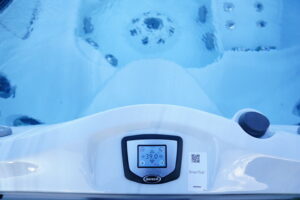
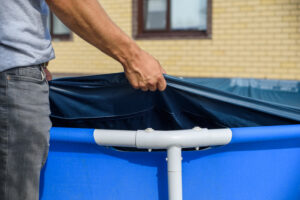
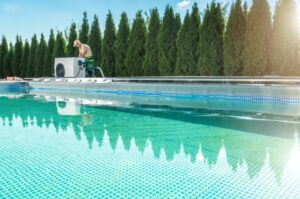
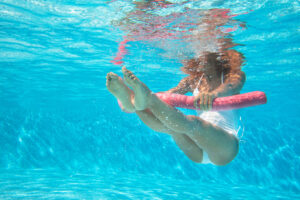

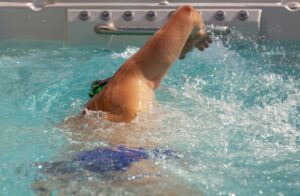

 by
by 